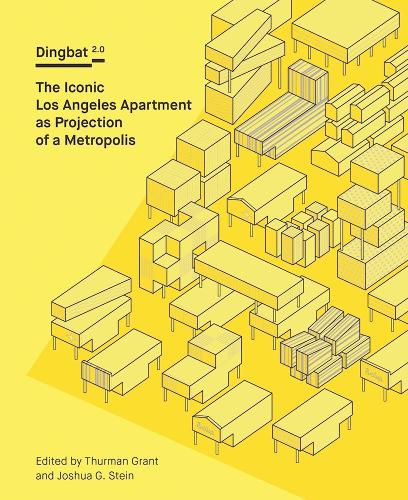
Dingbat 2.0: The Iconic Los Angeles Apartment as Projection of a Metropolis
(Paperback)
Publishing Details
Dingbat 2.0: The Iconic Los Angeles Apartment as Projection of a Metropolis
By (Author) Thurman Grant
Edited by Joshua G. Stein
Contributions by Aaron Betsky
Contributions by Barbara Bestor
Photographs by Judy Fiskin
DoppelHouse Press
DoppelHouse Press
15th March 2016
United States
Classifications
General
Non Fiction
Physical Properties
Paperback
288
Width 196mm, Height 241mm
836g
Description
Dingbat 2.0 is the first critical study of the most ubiquitous and mundane building type in Los Angeles: the dingbat apartment. Often dismissed as ugly and unremarkable, dingbat apartments have qualities that arguably make them innovative, iconoclastic, and distinctly L.A. For more than half a century the idiosyncratic dingbat has been largely anonymous, occasionally fetishized and often misunderstood.
Praised and vilified in equal measure, dingbat apartments were a critical enabler of Los Angeles rapid postwar urban expansion. While these apartments are known for their variety of midcentury decorated facades, less explored is the way they have contributed to a consistency of urban density achieved by few other twentieth century cities.
Dingbat 2.0 integrates essays and discussions by some of todays leading architects, urbanists and cultural critics with photographic series, typological analysis, and speculative designs from around the world to propose alternate futures for Los Angeles housing and to consider how qualities of the inarguably flawed housing type can foreground many crucial issues facing global metropolises today.
Published in cooperation with The Los Angeles Forum for Architecture and Urban Design. Book design: Jessica Fleischmann/still room.
Reviews
The book successfully leverages the dingbat as a launchpad for surveying multi-family housing in Los Angeles, picking apart the prickly and multivalent nature of its creation myth and subsequent existence through the lenses of prior appreciation, scholarly interest, and post-war art production. [...] A sprawling examination of the economic, social, and technocratic instruments developers, architects, and occupants used to design, build, and enjoy one of L.A.'s most unsung contributions to architectural-historical patrimony. [...] The book's central matter, the field guide to dingbats, will change the way you see L.A. --Antonio Pacheco, The Architects Newspaper Dingbat 2.0 gives an often-maligned Los Angeles building type its long overdue moment in the sun, not only advancing a sophisticated typology of dingbats, but also reimagining the potential of the dingbat for the twenty-first century--at a moment when the imperative to create livable and modest affordable housing is more pressing than ever. -- Ken Bernstein, Principal City Planner, Los Angeles Department of City Planning and Office of Historic Resources This book is extremely valuable for designers, particularly when one considers that architects generate species of buildings. An in-depth study of this particularly indigenous species to Los Angeles allows architects to not only become familiar with the causes and effects of the dingbat, but also the many possibilities for its future morphologies. -- Jimenez Lai, founder and creator of Bureau Spectacular One of the many brilliances of this great book is the telling comparison of Le Corbusier's Villa Savoye--raised on its skinny pilotis to create an entirely ornamental void--and the dingbat--likewise lally column-upped in the air but usefully making room for cars beneath. Ever not quite modern, Corb pontificated about "machines for living" while never quite knowing what to do with their true enabler: the machine for leaving. The indelible dingbat is a sandwich of necessity and desire that bespeaks the throwaway (and getaway) modernity uniquely Made in L.A. -- Michael Sorkin, Architect, Urbanist and Author; Principal, Michael Sorkin Studio
Author Bio
Co-editorThurman Grant is a Los Angeles based architect and educator (thurmangrant.com). He is a faculty member of the Interior Architecture Department at the Woodbury University School of Architecture, and through the university has taught in related programs in China and Italy. Grant has contributed to a long list of built residential, commercial, institutional and urban design projects, as well as award-winning design competitions in the U.S. and Asia. In 2011 he partnered with artist Olivia Booth on the installation Schindler Lab, Round One at the MAK Center for Art and Architecture at the Schindler House in West Hollywood, Los Angeles. Grant is a former president of the LA Forum Board of Directors and was a project leader for the Dingbat 2.0 competition and exhibition. Co-editor Joshua G. Stein is the founder of Radical Craft (radical-craft.com), a Los Angeles-based studio that advances design saturated in history (from archaeology to craft) and inflects the production of contemporary urban spaces and artifacts, evolving newly grounded approaches to the challenges posed by virtuality, velocity, and globalization. He has taught at the California College of the Arts, Cornell University, SCI-Arc, and the Milwaukee Institute of Art & Design. He was a 2010-11 Rome Prize Fellow in Architecture, and is currently Professor of Architecture at Woodbury University. He is also a former member of the LA Forum Board of Directors and was a project leader for the Dingbat 2.0 competition and exhibition.
